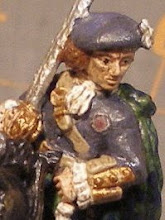I've been slightly delinquent in posting here about my miniature wargaming activities since our large Franco-German War game back in January. But I'm hoping to make up for it now.
As the title states, I've finally completed the last detachments for the 3rd Prussian Brigade and regiments for the III Korps cavalry. My previous
post back in July 2019 recorded the completion of the 4th Brigade. As I wrote there, the Prussian brigades in 1813 were really division equivalent all-arms commands and were called such to get around the onerous French restrictions after the Treaty of Tilsit.
The 3rd Brigade, commanded by
Generalmajor Prinz von Hessen-Homburg, consisted of:
Infantry Regiment #4, 3rd East Prussian of three battalions (two musketeer and one fusilier)
Reserve Infantry Regiment #4 of three musketeer battalions
2nd East Prussian Grenadier Battalion (with companies from both the 3rd and 4th East Prussian Regiments
3rd East Prussian Landwehr Infantry Regiment of three musketeer battalions
Hussar Regiment #1, 1st Leib Husaren
Foot Artillery Company #5 with 6-lbr guns
The 3rd East Prussian Regiment, 2nd East Prussian Grenadier Battalion, and 1st Leib Husaren Regiment all had freiwilligen (volunteer) jager detachments. These were composed of young men fron well-to-do families who provided their own items of clothing and equipment that had to generally meet army requirements. The foot jagers were normally armed with the family's hunting rifle while the mounted jagers could have that or a short carbine.
Here are the foot jager detachments that I recently painted, completing the 3rd Brigade. They are vintage Scruby true 25mm castings.
 |
| Volunteer Jager Detachment, 2nd East Prussian Grenadier Battalion |
 |
| Two Volunteer Jager Detachments, 3rd East Prussian Infantry Regiment |
I also completed the III Korps cavalry contingent. The corps cavalry was where almost all the cavalry in the corps could be found, although some regiments could be attached to the brigades for various operations. The III Korps Cavalry was commanded by
Generalmajor von Oppen and consisted of eight regiments:
1st Brigade (Oberst [Colonel] von Teskow)
Dragoon Regiment #1, Koningen (Queen's)
Dragoon Regiment #4, 2nd West Prussian
Dragoon Regiment #5, Brandenburg
2nd Brigade (Oberst von Hobe)
Hussar Regiment #6, 2nd Silesian
Uhlan Regiment #1, West Prussian
3rd Brigade (Oberstleutnant (Lieutenant Colonel) von Sydow)
2nd Pomeranian Landwehr Cavalry Regiment
2nd Kurmark Landwehr Cavalry Regiment
4th Neumark Landwehr Cavalry Regiment
All three dragoon regiments and the uhlan regiment had mounted volunteer jager detachments. The ones from the 2nd West Prussian Dragoons and West Prussian Uhlans were finally painted as well as the Kurmark and Neumark Landwehr Cavalry and the 3rd Brigade commander.
 |
Volunteer Jager Detachments of the 2nd West Prussian Dragoons (left) and the West Prussian Uhlans (right).
The figures are MiniFigs Prussian riders on Prinz August (I think) horses. |
 |
Complete 2nd West Prussian Dragoon Regiment with volunteer jagers.
The dragoons are Prussian MiniFigs.
You can see that the jagers' horses are bigger so I may try to get MiniFigs horses to replace them. |
 |
Complete West Prussian Uhlan Regiment with volunteer jagers.
The uhlans are Hinchliffe figures. |
 |
| 2nd Kurmark Landwehr Cavalry Regiment (Hinchliffe figures). |
 |
| 4th Neumark Landwehr Cavalry Regiment (Hinchliffe figures) |
 |
Oberstleutnant con Sydow, 3rd Cavalry Brigade Commander.
A Hinchliffe figure wearing the uniform of the Pomeranian Landwehr Cavalry (from where he was assigned). |
I now have two brigades (division equivalents) and the Corps cavalry completed from the Prussian III Korps, commanded by
Generalleutnant von Bülow. The corps was assigned to the allied Army of the North, commanded by the Prince Regent of Sweden (former French Marshall Bernadotte). I'm also almost finished with the corps artillery, having only one 6-lbr foot company left to paint. They should be done shortly as I have more time now-a-days. Once I get that done, I plan of a major review of all my Prussian forces. Stay tuned!



























